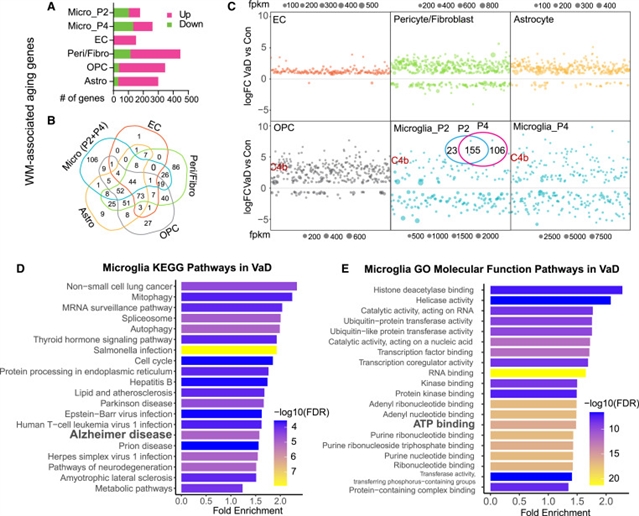
解构局灶性缺血血管性痴呆的细胞间相互作用及其治疗应用,这一成果由神经内科S. Thomas Carmichael研究小组经过不懈努力而取得。2025年6月30日出版的《细胞》杂志发表了这项成果。
为了阐明关键的细胞间通路,该研究团队采用局灶性缺血VaD motheme模型,结合转录组学和功能分析,复制了人类VaD复杂病理生理的许多要素。通过整合细胞类型特异性motheme VaD转录组和人类VaD单核RNA测序(snRNA-seq)数据(4053对人类和2032对motheme),确定了两个物种中保守的失调细胞间通路。研究人员证明了两个细胞间信号系统Serpine2-Lrp1和CD39-A3AR在VaD中被破坏。Serpine2表达减少可增强少突胶质细胞祖细胞(OPC)分化,促进修复,而A3AR特异性激动剂(目前用于银屑病的临床试验)可恢复VaD模型中的组织完整性和行为功能。本研究揭示了细胞间信号靶点,为VaD的创新治疗提供了基础。
据悉,血管性痴呆(VaD)是痴呆症的第二大主题,主要是一种白质缺血性疾病,没有直接治疗方法。病变部位的细胞间相互作用决定了疾病的进展或修复。
附:英文原文
Title: Deconstructing the intercellular interactome in vascular dementia with focal ischemia for therapeutic applications
Author: Min Tian, Riki Kawaguchi, Yang Shen, Michal Machnicki, Nikole G. Villegas, Delaney R. Cooper, Natalia Montgomery, Ying Cai, Jacqueline Haring, Ruirui Lan, Angelina H. Yuan, Christopher K. Williams, Shino Magaki, Harry V. Vinters, Ye Zhang, Lindsay M. De Biase, Alcino J. Silva, S. Thomas Carmichael
Issue&Volume: 2025-06-30
Abstract: Vascular dementia (VaD), the second-leading cause of dementia, is primarily a white matter ischemic disease with no direct therapies. Cell-cell interactions within lesion sites dictate disease progression or repair. To elucidate key intercellular pathways, we employ a VaD mouse model with focal ischemia replicating many elements of the complex pathophysiology of human VaD combined with transcriptomic and functional analyses. By integrating cell-type-specific mouse VaD transcriptomes and human VaD single-nucleus RNA sequencing (snRNA-seq) data plus a custom ligand-receptor database (4,053 human and 2,032 mouse pairs), conserved dysregulated intercellular pathways in both species are identified. We demonstrate that two intercellular signaling systems, Serpine2-Lrp1 and CD39-A3AR, are disrupted in VaD. Reduced Serpine2 expression enhances oligodendrocyte progenitor cell (OPC) differentiation, promoting repair, while an A3AR-specific agonist—currently in clinical trials for psoriasis—restores tissue integrity and behavioral function in the VaD model. This study reveals intercellular signaling targets and provides a foundation for developing innovative therapies for VaD.
DOI: 10.1016/j.cell.2025.06.002
Source: https://www.cell.com/cell/abstract/S0092-8674(25)00636-1
